Incorporating AI solutions into RV repair processes offers significant opportunities to enhance efficiency and revolutionize maintenance practices. By leveraging artificial intelligence, repair shops can streamline diagnostics, predict common issues, optimize service procedures, and improve overall operational efficiency. AI also assists in administrative tasks, customer inquiries, and quality inspection, leading to reduced unexpected breakdowns and improved repair quality. To integrate AI effectively, assess current workflows, choose relevant tools, conduct pilot tests, train staff, and seamlessly integrate AI into existing processes. Measure success using KPIs such as reduced repair time, diagnostic accuracy, customer satisfaction, and minimized inventory errors, enabling strategic planning for future AI adoption.
“Revolutionize your RV repair shop with AI solutions – the key to unlocking unparalleled efficiency in the maintenance landscape. This comprehensive guide explores the untapped potential of artificial intelligence, offering a strategic roadmap for RV shops to enhance operations.
From understanding the unique application of AI in RV repairs to implementing practical steps and measuring success through performance indicators, we delve into actionable strategies. Discover how these advanced technologies can streamline processes, reduce costs, and elevate your shop’s reputation in the competitive market.”
- Understanding AI Potential for RV Repair: Unlocking Efficiency Gaps
- Implementing AI Solutions: A Step-by-Step Guide for RV Shops
- Measuring Success: Key Performance Indicators for AI in RV Maintenance
Understanding AI Potential for RV Repair: Unlocking Efficiency Gaps

In the realm of RV repair, embracing AI solutions offers a game-changing opportunity to unlock significant efficiency gaps. By integrating artificial intelligence technologies, repair shops can streamline processes that were once time-consuming and labor-intensive. AI has the potential to revolutionize RV maintenance by providing accurate diagnostics, predicting common issues, and optimizing service procedures. For instance, AI algorithms can analyze vast amounts of data from sensor readings and historical repairs to identify patterns and suggest proactive maintenance plans, reducing unexpected breakdowns.
The benefits extend beyond improved accuracy and reduced downtime. AI solutions can enhance overall operational efficiency by automating administrative tasks, such as scheduling appointments and managing inventory. Natural Language Processing (NLP) chatbots can handle customer inquiries, providing quick support and freeing up staff for more complex work. Additionally, computer vision algorithms can inspect RV components for defects or wear and tear, ensuring higher-quality repairs and safety standards.
Implementing AI Solutions: A Step-by-Step Guide for RV Shops

Implementing AI solutions can significantly enhance the operational efficiency of RV repair shops, streamlining processes and improving overall productivity. Here’s a step-by-step guide for RV shops looking to integrate AI into their operations:
1. Assess Current Processes: Begin by thoroughly understanding your current maintenance workflows. Identify pain points, such as repetitive tasks or inefficiencies in diagnostic procedures, where AI could provide the most value. This involves evaluating the types of repairs commonly performed and the tools currently used.
2. Choose Relevant AI Solutions: Based on your assessment, select AI tools that directly address your identified needs. For RV maintenance, this might include computer-aided diagnosis (CAD) systems for faster and more accurate identifications of issues or predictive analytics software to anticipate potential repairs before they become major problems.
3. Pilot Testing: Before full-scale implementation, conduct pilot tests with a small group of repairs or in a specific department. This allows for adjustments and fine-tuning of the AI system without disrupting the entire shop. It also provides valuable data on the system’s effectiveness in real-world scenarios.
4. Training and Integration: Once satisfied with the pilot results, train your staff on using the new AI tools effectively. Ensure they understand how to input data accurately and interpret the AI outputs. Seamlessly integrate these solutions into existing workflows for a smooth transition.
Measuring Success: Key Performance Indicators for AI in RV Maintenance

Measuring success is paramount when implementing AI solutions for improving RV maintenance efficiency. Key Performance Indicators (KPIs) should be set to track the impact and return on investment (ROI) of these technologies. For instance, reduction in repair time per unit can serve as a primary KPI, indicating improved operational efficiency. Additionally, tracking the accuracy rate of AI-driven diagnostics compared to human assessments can demonstrate the reliability of automated systems. Another important metric is customer satisfaction, gauged through feedback on turnaround times and the quality of repairs.
Furthermore, monitoring the reduction in parts inventory errors and waste can highlight AI’s contribution to cost optimization. By analyzing historical data and comparing it with post-AI implementation figures, shops can assess improvements in predictive maintenance accuracy and overall maintenance costs. These KPIs not only help in gauging the effectiveness of AI solutions but also enable informed decision-making for future strategic planning.
AI has the potential to revolutionize RV repair shops by significantly improving maintenance efficiency. By implementing tailored AI strategies, such as predictive analytics for parts replacement and automated diagnostic tools, shops can streamline their processes and reduce costs. Through careful measurement of key performance indicators, RV maintenance professionals can ensure that AI solutions are enhancing, not complicating, their work. Embracing these advanced technologies is a smart step towards staying competitive in the modern automotive industry.
